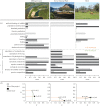Measuring rewilding progress
- PMID: 30348877
- PMCID: PMC6231071
- DOI: 10.1098/rstb.2017.0433
Measuring rewilding progress
Erratum in
-
Correction to 'Measuring rewilding progress'.Philos Trans R Soc Lond B Biol Sci. 2019 Feb 4;374(1765):20180568. doi: 10.1098/rstb.2018.0568. Philos Trans R Soc Lond B Biol Sci. 2019. PMID: 30967010 Free PMC article. No abstract available.
Abstract
Rewilding is emerging as a promising restoration strategy to enhance the conservation status of biodiversity and promote self-regulating ecosystems while re-engaging people with nature. Overcoming the challenges in monitoring and reporting rewilding projects would improve its practical implementation and maximize its conservation and restoration outcomes. Here, we present a novel approach for measuring and monitoring progress in rewilding that focuses on the ecological attributes of rewilding. We devised a bi-dimensional framework for assessing the recovery of processes and their natural dynamics through (i) decreasing human forcing on ecological processes and (ii) increasing ecological integrity of ecosystems. The rewilding assessment framework incorporates the reduction of material inputs and outputs associated with human management, as well as the restoration of natural stochasticity and disturbance regimes, landscape connectivity and trophic complexity. Furthermore, we provide a list of potential activities for increasing the ecological integrity after reviewing the evidence for the effectiveness of common restoration actions. For illustration purposes, we apply the framework to three flagship restoration projects in the Netherlands, Switzerland and Argentina. This approach has the potential to broaden the scope of rewilding projects, facilitate sound decision-making and connect the science and practice of rewilding.This article is part of the theme issue 'Trophic rewilding: consequences for ecosystems under global change'.
Keywords: biodiversity; ecological processes; ecosystem integrity; ecosystem management; monitoring; restoration.
© 2018 The Authors.
Conflict of interest statement
W.H., D.S. and F.S. work at Rewilding Europe. They have endeavoured to be as honest and balanced as possible and to write in the spirit of academic discussion rather than organizational promotion.
Figures


References
-
- Benayas JMR, Bullock JM. 2012. Restoration of biodiversity and ecosystem services on agricultural land. Ecosystems 15, 883–899. (10.1007/s10021-012-9552-0) - DOI
Publication types
MeSH terms
Associated data
LinkOut - more resources
Full Text Sources

